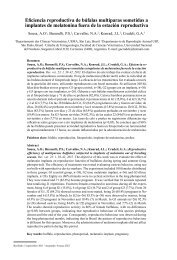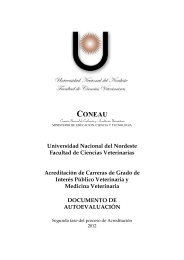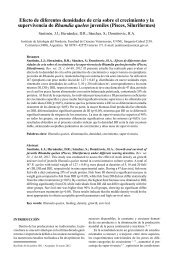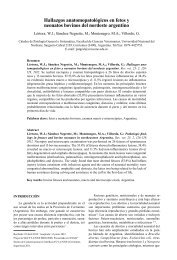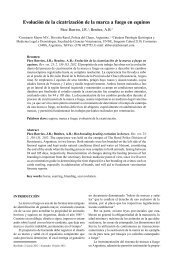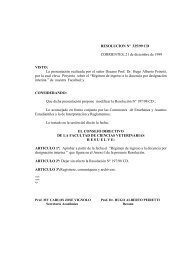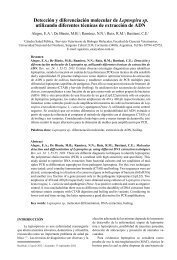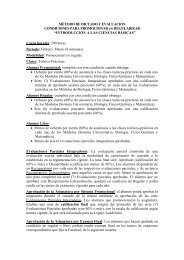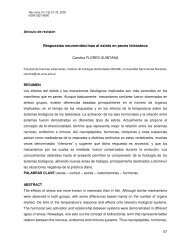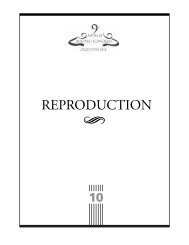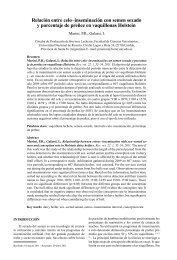MILK PRODUCTION
MILK PRODUCTION
MILK PRODUCTION
Create successful ePaper yourself
Turn your PDF publications into a flip-book with our unique Google optimized e-Paper software.
574<br />
<strong>MILK</strong> <strong>PRODUCTION</strong><br />
is not an automatic cluster detachment device. Milk ejection is influenced by anatomical 13 , physiological 13 , environmental<br />
factors and health status 4 .<br />
Buffalo species is characterized by low cisternal fraction and long teat and teat canal length, if compared to cow and<br />
small ruminant. It is very well studied 14 and known, that in dairy cow, about 20% of milk is stored in the cisternal<br />
compartment and it is immediately available for milking, in goat 6 and ewe 6 the cisternal fraction amounts to more than<br />
50%, on the contrary in buffalo species the cisternal fraction is very small, ranged between 5% - 8% of the total milk 1,13 .<br />
In Murrah buffaloes 16 has been calculated a mean teat length as 5.8-6.8 cm for front teats and 6.9-7.8 cm for behind<br />
teats. Thomas 13 reported values from 5 to 14 cm for front teats and from 8 to 16 cm for behind teats, with teat canal<br />
length about 3.1 cm in the hind than fore quarters. Buffalo species are reported to be difficult to be machine milked<br />
compared to cows. An explanation could be due to the longer teat canal, if compared to cows 14 which have been<br />
measured by an established ultrasound method 1,6,11 . In Mediterranean Italian buffalo 1 teat length is 7.45±0.44 and<br />
7.53±0.76 in hind and fore teat respectively. Therefore a large variability among different river breeds was found,<br />
according to the genetic differences and to the milking system (manual or mechanical) 13 . In this study we investigate<br />
the influence of the teat anatomy (with particular regard to teat canal length) on milkability (milk flow curve). The aim<br />
of this study was to demonstrate possible relationships between milk flow parameters and teat anatomy.<br />
MATERIALS AND METHODS<br />
Sixteen Mediterranean Italian buffalo cows, from the Tormancina Farm (Animal Production Research Centre of CRA) in<br />
Monterotondo, Italy. were used for this experiment. They were characterized by Parity 3.1±0.4, days in milk (DIM)<br />
126±17, clinical health. Each buffalo cow was recorded every one months, in morning and evening milking. Buffalo cows<br />
were milked at 08:30 AM and 19:00 PM in a Herringbone parlour (8+8), the milking vacuum was set at 42 kPa, pulsation<br />
rate was 60 cycles/min, with a pulsation ratio of 60:40. Milking clusters detachment were excluded and the stripping<br />
phase was normally performed. Milk yield and milk flow parameters were described in Lactocorder ® (WMB AG Balgach)<br />
manual instructions of this device. Oxytocin administration was useful (20 I.U. - i.m.) for each buffalo cows about two<br />
minutes of attachment milking cluster. 160 (80 morning, 80 evening) milk flow curve were recorded during the trial. Teat<br />
length, teat diameter, teat wall thickness, cisternal diameter (4.0 cm above the teat tip) and teat canal length were<br />
evaluated before first day of experiment at morning milking at start of the trial. Teat length of the front and rear quarter<br />
from each buffalo cow were measured by using a ruler. Teat diameter, teat wall thickness, cisternal diameter, and teat canal<br />
length (figure 1) were evaluated using longitudinal cross section b-mode ultrasound images (Aloka SSD-500, Aloka CO.<br />
Ltd., Tokyo, Japan). The images were recorded with a 7.5 MHz-linear probe (see figure 1). The analyzed teats were merged<br />
in a cup of hand-warm water. The ultrasound probe was closed to the outside of the cup. Between the probe an the cup<br />
was applied ultrasound gel. The statistical analysis were carried on by MedCalc ® V 9.3.0.0, results are presented as<br />
means ± standard error of mean, using t test to compare mean results (levels were considered significant when P=0.05).<br />
RESULTS AND DISCUSSION<br />
The teat anatomy measurements are shown in table 1. Teat length, cisternal diameter and the teat diameter are significantly<br />
higher in rear than in front quarters. The average length of the teats is greater than that reported by Ole Lind 16 ,<br />
which indicates the Murrah breed for front teats are, on average, 5.8 cm to 6.4 cm for the hind teats are 6.9 cm to 7.8<br />
cm. In an other study, Thomas 13 found very higher teat length (from 9.02 cm in front to 11.80 cm in rear teats).<br />
Differences in teat and cisternal diameter between front and rear teats were also significant (P



